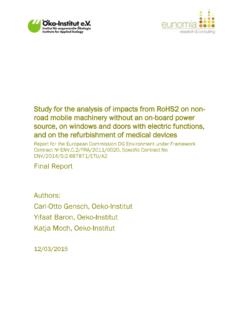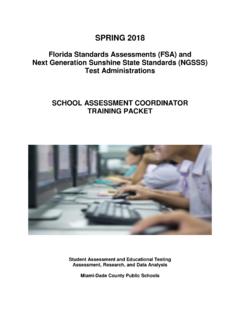Transcription of 1st Stakeholder Consultation - rohs.exemptions.oeko.info
1 Study to support the review of the list of restricted substances and to assess a new exemption request under RoHS 2 (Pack 15) 1st Stakeholder Consultation Compilation of initial substance information for tetrabromobisphenol A - TBBP-A (CAS 79-94-7 ; EC 201-236-9) Abbreviations ABS Acrylonitrile Butadiene Styrene CLP Regulation (EC) No 1272/2008 on Classification, Labelling and Packaging CoRAP Community Rolling Action Plan ECHA European Chemical Agency EFRA European Flame Retardants Association GADSL Global Automotive Declarable Substance List OSPAR Oslo and Paris Conventions; to protect the marine environment of the North-East Atlantic REACH Regulation (EU) No 1907/2006 on the Registration, Evaluation, Authorisation and restriction of Chemical substances SIN SIN (Substitute it Now!) List of the NGO ChemSec TBBP-A Tetrabrombisphenol A PCB Printed Circuit Board 1.
2 Legal status and other restrictions Tetrabromobisphenol A (TBBP-A) is classified under the CLP regulation (Regulation (EC) No 1272/2008 on Classification, Labelling and Packaging) with the following entries:1 Aquatic Acute 1 (Hazardous to the aquatic environment) - H400 (Very toxic to aquatic life) Aquatic Chronic 1 (Hazardous to the aquatic environment) - H410 (Very toxic to aquatic life with long lasting effects) TBBP-A was included in the Community Rolling Action Plan (CoRAP) list by the Danish EPA (Danish Ministry of the Environment) on the basis of the following grounds for concern:2 Suspected Reprotoxic Potential endocrine disruptor Suspected PBT/vPvB Consumer use Exposure of environment Exposure of workers 1 , last viewed 2 , last viewed Study to support the review of the list of restricted substances and to assess a new exemption request under RoHS 2 (Pack 15) 2/4 High (aggregated) tonnage Wide dispersive use The ECHA has requested further information (on human toxicity, use and exposure) and testing in March TBBP-A was included in the OSPAR List of Chemicals for Priority Action in 2000.
3 TBBP-A is considered to meet all three of the OSPAR criteria for the PBT (persistent, bioaccumulative and toxic) assessment, though it is noted that TBBP-A is a borderline case regarding the bioaccumulation Despite the OSPAR listing, TBBP-A does not meet the criteria for a PBT or a vPvB substance under REACH. A risk assessment for the environment of the US EPA (2015) concludes that the additive use of TBBP-A is toxic for the aquatic environment and is very TBBP-A was already added to the SIN list in September 2008, because reprotoxic and endocrine disruptive effects have been reported6. Moreover TBBP-A is on several other substance lists ( at member state level the List of Undesirable Substances of the Danish EPA7 and at industry level on the Global Automotive Declarable Substance List (GADSL)8).. 2. Uses and quantities The primary use of TBBP-A is as a reactive flame retardant in printed circuit boards (PCBs).
4 PCBs are commonly found in consumer and industrial electronic products, including computers and mobile phones. TBBP-A is used as a reactive component of flame-retarded epoxy and polycarbonate resins, which account for approximately 90% of the use of TBBP-A. The two main applications for epoxy resins are: Epoxy resins in printed circuit boards (rigid or reinforced laminated printed circuit boards most commonly based on glass fibre reinforced epoxy resin (designated FR4-type): used in nearly all types of EEE. Epoxy resins to encapsulate certain electronic components, plastic/paper capacitors, microprocessors: used in plastic/paper capacitors, microprocessors, bipolar power transistors, IGBT (Integrated Gate Bipolar Transistor) power modules, ASICs (Application Specific Integrated Circuits) and metal oxide varistors) on the printed circuit board.
5 An additional reactive flame retardant use is in polycarbonate and unsaturated polyester resins. TBBP-A is also used as an additive flame retardant in polymeric material in housings and packaging. As an additive flame retardant TBBP-A is mainly used in acrylonitrile-butadiene-styrene (ABS) resins 3 , last viewed 4 OSPAR (2011): Background Document on Tetrabromobisphenol-A. , last viewed 5 US EPA (2015): Flame retardants in Printed Circuit Boards, Environmental Protection Agency (EPA) Final report August 2015, , last viewed 6 SIN list database: , last viewed 7 DEPA (2011): Danish Ministry of the Environment; List of Undesirable Substances 2009 , last viewed 8 GADSL (2018) Global Automotive Declarable Substance List, , last viewed Study to support the review of the list of restricted substances and to assess a new exemption request under RoHS 2 (Pack 15) 3/4 and accounts for approximately 10% of TBBP-A use.
6 It is applied in a wide range of non-EEE applications, but also for encapsulating electrical devices. ABS is widely used for the inner housings of refrigerators. The information from the Joint Submission of the TBBP-A registration at ECHA indicates a total tonnage band of 1,000 to 10,000 tonnes per This is a clear decrease compared to the amounts identified in the Oeko-Institut study in 2008 that estimated the demand for EEE at a total of around 40,000 tonnes per year (based on data for 2003/2005,10 see the following table). Based on available data, it is estimated that the amounts of TBBP-A used are divided between the applications mentioned above as detailed in the table below. Table 1: Amounts of TBBP-A in applications Application Different use amounts in tonnes per annum Percentage Epoxy resins in printed circuit boards (reactive component) 900 (own calculation based on European Flame Retardants Association EFRA 2014)11 5,850 (Oeko-Institut 2008) 90% Epoxy resins to encapsulate certain electronic components (reactive component)12 100 250 (own calculation based on European Flame Retardants Association EFRA 2014) 10% Polycarbonate and unsaturated polyester resins (reactive component) ABS13 (additive flame retardant) Total 1,000 to 10,000 (ECHA 2018) (European Flame Retardants Association EFRA 2014)14 (Oeko-Institut 2008) 100% 9 ECHA (2018): ECHA Registered Substances Database (2018): Entry for 2,2',6,6'-tetrabromo-4,4'-isopropylidene diphenol.
7 , last viewed 10 Oeko-Institut (2008): Study on Hazardous Substances in Electrical and Electronic Equipment, Not Regulated by the RoHS Directive by Gro , R.; Bunke, D.; Gensch, ; Zangl, S.; Manhart, A.; Contract No. 070307/2007/4768 36/MAR/G4; Final Report 17 October 2008; , last viewed 11 Oeko-Institut (2014): Study for the Review of the List of Restricted Substances under RoHS 2. Analysis of Impacts from a Possible Restriction of Several New Substances under RoHS 2 by Gensch, , Baron, Y. Blepp, M., Bunke, D., Moch, K.; Revised Final Version ; , last viewed 12 Plastic/paper capacitors, microprocessors: used in plastic/paper capacitors, microprocessors, bipolar power transistors, IGBT (Integrated Gate Bipolar Transistor) power modules, ASICs (Application Specific Integrated Circuits) and metal oxide varistors) 13 ABS is widely used for the inner housings of refrigerators.
8 14 Oeko-Institut (2014): Study for the Review of the List of Restricted Substances under RoHS 2. Analysis of Impacts from a Possible Restriction of Several New Substances under RoHS 2 by Gensch, , Baron, Y. Blepp, M., Bunke, D., Moch, K.; Revised Final Version ; , last viewed Study to support the review of the list of restricted substances and to assess a new exemption request under RoHS 2 (Pack 15) 4/4 According to Table 1, aside from the use of TBBP-A as a reactive flame retardant in printed circuit boards, there is a lack of detailed data for any other applications. This could create the impression that the quantities of TBBP-A used in Europe have decreased substantially to between 1,000 to 2,500 tonnes (EFRA 2014) compared to the quantity evaluation of the Oeko-Institut in 2008 and the submitted data from ECHA. However EFRA explains the lack of further detail to be because the exact figures cannot be provided due to anti-trust rules.
9 The data from the ECHA registration system must also be viewed with caution, seeing as it does not reflect all TBBP-A being placed on the EU market. For example, the majority of PCBs are imported from China. This means that TBBP-A also enters the EU in imported articles and the figures mentioned above are most probably an under estimation as they only represent TBBP-A manufactured or acquired for use in manufacture taking place in the EU. The figures above do not include the import of TBBP-A contained in partly finished products ( master-batch, epoxy resins) and in finished products and components15. 3. Substitution According to the study of the US EPA (2015), the Design for the Environment (DfE) chemical alternatives assessments16 provide extensive information on chemical hazards and a more general discussion of other factors relevant to substitution decisions, such as: use information for critical endpoints and exposure and life -cycle considerations.
10 This study investigated eight halogen-free alternative flame-retardants and concluded that the halogen-free flame-retardant laminates tested have electrical and thermo-mechanical properties that meet or exceed those of brominated laminates and that laminate suppliers can meet the demand for halogen-free flame-retardant PCB materials. The most successful alternative available to date is 9,10-Dihydro-9-oxa-10-phosphaphenanthren e-10-oxide (DOPO) due to the monofunctional nature of its structure; DOPO has to be reacted into specific multifunctional epoxies. 15 Oeko-Institut (2014): Study for the Review of the List of Restricted Substances under RoHS 2. Analysis of Impacts from a Possible Restriction of Several New Substances under RoHS 2 by Gensch, , Baron, Y. Blepp, M., Bunke, D., Moch, K.; Revised Final Version ; , last viewed 16 , last viewed
















